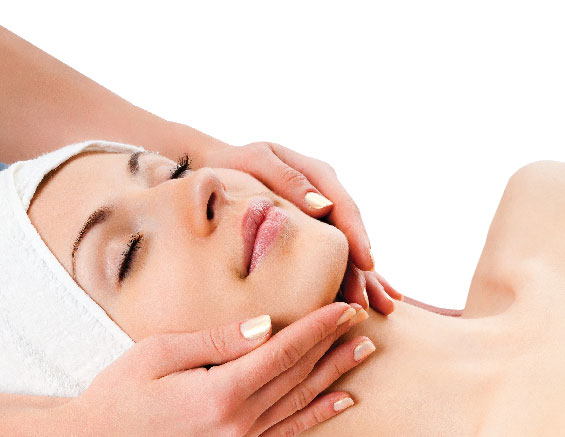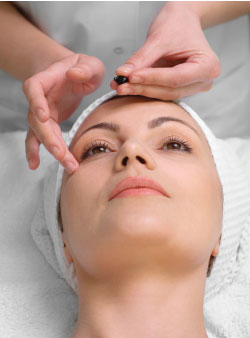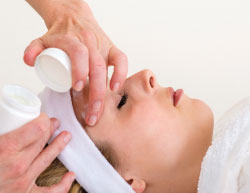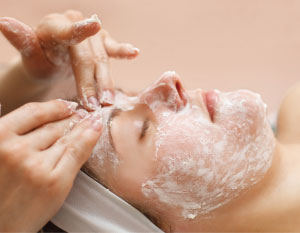Integrating add-on treatments in your services is a popular and undeniable need for skin care professionals. For the purpose of this article, we will concentrate on facial treatment add-ons. This analysis could easily be applied to body treatments and other services.
I am often asked: is it better to include all steps of a service into a facial, use an upscale product line, and charge a high price skin professional – or is it better to offer an entry level or low price facial and up-sell it by having the skin care professional recommend add-on services and higher-priced products during the facial?
THE BUSINESS MODEL
To determine what fits your particular business, several things should be considered. First, if your business is established, what demographics/type of clientele do you currently have? If you are starting a new business, what segment of your local market do you wish to attract? You cannot attract every type of client. Starbucks and Dunkin’ Donuts do not attract the same coffee clientele for coffee. Next, what are the management team’s or owner’s preferences? You must love your business to enjoy working in it every day. Last but not least, what are your aestheticians’ skills and likes – do they like up-selling services? Are they good at communicating? Are you ready to replace staff if needed? Or do you prefer your clients pick their facial online when they book their appointments? The answers to these questions will help your management team choose the business model that fits your particular case and guide you in developing a service menu that will bring profits and customer retention.

MENU OPTIONS
We will explore four different types of spa menus, giving you options to fit your business model.
OPTION #1
The first option is offering a menu listing a few facials that represent the industry’s gold standard. These facials include upscale products and extra services – no expense spared – to ultimately achieve the best outcome to the following:
- Address a therapeutic purpose to improve a skin condition, which is often the main reason a client books a facial. A menu may include as few as three different facials: anti-aging, acne, or pigmentation.
- Include services such as eye and lip treatments, hand/arm massage and hot mitts, which includes the neck and décolleté, and serum application.
- Experience the ultimate pampering experience.
- No up-selling of services during the facial. There are no or few add-ons, because all is included in the price of the facial. The few possible add-ons are enzyme or other peels and the use of some devices. Lymphatic drainage is typically included in the base price for its detoxification and therapeutic purposes. Home care product recommendations are an integral part of the skin care program. The spa differentiates itself from most competitors by its upscale positioning, atmosphere, service, sophisticated, and highly skilled staff.
 PROS: If your business is the upscale spa in town, this menu will attract the clients you target. Retail sales are high because each skin care professional uses high-end products that are also available for retail. The professional has more time to sell retail because he/she does not have to up-sell services. There is no hard sale.
PROS: If your business is the upscale spa in town, this menu will attract the clients you target. Retail sales are high because each skin care professional uses high-end products that are also available for retail. The professional has more time to sell retail because he/she does not have to up-sell services. There is no hard sale.
CONS: Facials take longer because of the extras; they cost a few more dollars, but should not be an issue because of the higher price charged for facials.
OPTION #2
Here is a menu listing a few inexpensive facials, as well as many optional add-ons:
- The facials only include the basic steps: the client and professional have many options to personalize the facial for therapeutic purposes or for price considerations.
- Add-on services such as eye massage, mechanical lymphatic drainage, and use of various devices add to the quality of the facial and to the price.
- Few products are included with the base price; those products are limited to a cleanser, toner, scrub, massage cream, mask, and moisturizer. This keeps the price of the facial down.
- The professional products used are low-cost; a higher-end line is available at an extra charge.
- Specialty products are added at an extra charge: face and eye serums, eye and lip moisturizer, specialty mask, enzyme peel, or glycolic peel to replace a scrub.
- Extractions and products to ease extractions and control breakouts are an extra cost.
- A décolleté treatment is an extra cost (teenagers and young adults may skip the décolleté, while mature clients find it a necessity); the same is true for hand and arm treatments.
As far as products with this treatment menu, the spa has two options: The spa offers a choice of two product lines: a lower-priced line to attract a price sensitive clientele and a high priced line that delivers therapeutic results. On the other hand, the spa can offer only one line, which can be an upscale or a niche brand to attract an eclectic/out of the box thinking clientele who wants something unique or natural. Natural and high-tech, small brands represent the latest trend as per a report published by Diagonal Reports.
PROS: From the client’s perspective, one has a choice to control costs by refusing extra services or products, as well as choosing not to receive treatments that may not be valued: The client may not care for a hand massage. The purpose of adding services or products to a treatment serves therapeutic purposes as needed by the skin condition. It customizes the treatment; when analyzing a skin condition and discussing the client’s expectations, the skin care professional makes recommendations to add products or additional services to the treatment originally booked.
 Aestheticians educate clients about alternative treatments and upgrades to achieve a better outcome. Up-selling increases revenues for the business and the staff. The many add-ons and unique products help differentiate the spa from competitors, while attracting a wide range of clients. The add-ons increase each ticket and consequently, the spa’s profitability.
Aestheticians educate clients about alternative treatments and upgrades to achieve a better outcome. Up-selling increases revenues for the business and the staff. The many add-ons and unique products help differentiate the spa from competitors, while attracting a wide range of clients. The add-ons increase each ticket and consequently, the spa’s profitability.
CONS: Profitability depends on the staff’s ability to communicate the value of the upgrades to the clients and choose what will work on each client’s skin. The aesthetician must convince a client who booked a facial advertised at a low price (think Groupon) to upgrade it to achieve a better outcome. The low price serves as bait; this method may not sit well with a number of customers who feel they have been taken…. Furthermore, if the aesthetician dislikes up-selling or the clients do not want to be sold, the business will lose money. Without the upgrades, the facial’s outcome will be mediocre and this “lack of results,” as well as “lack of luxury,” may get criticized on social media. Anything less than 4.5 stars will cost you a lot of business.
OPTION #3
This menu is one that is a hybrid between the first and second menu ideas – it will include three to six facials at mid-to-up-market prices, as well as three to six higher-priced add-on services.
- The facials include all the steps expected in a European facial, including exfoliation, extraction of comedones, and application of serums.
- The treatment includes not just the face, but also the neck and décolleté.
- Add-ons offer options to upgrade the exfoliation method such as replacing a scrub with an enzyme peel for a small fee.
- Add-ons offer additional care: eye treatment, mechanical lymphatic drainage, if you have the device available.
- Additional time for extractions.
- Hand and arm treatment with hot mittens.

PROS: The menu is easy for clients to understand and is fast to read. It is quick for the staff to explain a few facials that clearly focus on skin conditions and what brand of product is used (such as xyz brands facial for anti-aging results… acne, pigmentation, rosacea, and so on).
Booking appointments is straight-forward because only the facial gets booked: The client and skin care professional will discuss specific needs/add-ons at the time of the facial. Furthermore, the website looks neat and organized, leading to more appointments made online: A great money and time-saver for the staff.
Recent research by Diagonal Reports indicates that clients aged 45 and over prefer having some choice in the selection of services and this type of menu fits that desire.
CONS: The business still relies on the aesthetician to up-sell and maximize profitability, even if it is to a lesser extent than with the second menu.
OPTION #4
Extensive menu of services: This is a similar concept to Chinese menus, offering a large variety of dishes as seen in many United States-based Chinese restaurants:
- This spa menu might be several pages long.
- It describes the brand(s) used to perform the facials; if no brand is listed, the client will assume the products used are cheap.
- It describes each step of the facial in detail such as: cleansing, toning, exfoliation, using xyz scrub, massage with steam, extractions, mask, abc serum, moisturizer, and sunscreen.
- Instead of listing add-on options as in the second and third menu options, this menu lists a multitude of facials, each with some small variation: one facial may include an enzyme peel, the next one is the same facial with a scrub instead of the enzyme peel, the third is the same facial with a glycolic peel, and the fourth with a lactic peel. An additional variation will offer the four described facials with different masks, for example.

PROS: Attracts clients who like to see all steps and products used in a facial.
CONS: The menu causes confusion; most clients do not differentiate between the facials and will not read the entire list of services offered on the menu. Because they do not understand or do not want to take time to read the list of services offered, they may not book. Statistically, only two or three facials sell in any given spa; others are almost never requested. Such a menu forces the spa to carry many products, some rarely used, and this adds to costs and waste. It may cause professional products to get old and lose their therapeutic properties. For the most part, product manufacturers recommend using products within six months after opening.
The spa’s print or online menu is often your first tool of communication with prospective clients. The menu not only describes the services, add-ons, and products used to perform those services, but conveys who you are as a business. A good menu will speak to your target client, who, in turn, will book a service on the spot without having to think about it.
 Catherine Atzen, MBA, CIDESCO, takes a progressive approach to skin care and product ideation. Her inspiration stems from her upbringing in a ‘green’ French spa town and the creativity of the San Francisco Bay Area where she resides. A talented product developer, she launched the newly formulated ATZEN Superior to Organic line chosen for the Academy Award’s celebrity gift box. Her products are favorites among Hollywood, and Atzen serves as skin care advisor to many celebrities. She also developed the LymphMed® device for lymphatic drainage. Atzen holds an MBA from UC Berkeley, an MBA from Columbia University, and is NCEA certified.
Catherine Atzen, MBA, CIDESCO, takes a progressive approach to skin care and product ideation. Her inspiration stems from her upbringing in a ‘green’ French spa town and the creativity of the San Francisco Bay Area where she resides. A talented product developer, she launched the newly formulated ATZEN Superior to Organic line chosen for the Academy Award’s celebrity gift box. Her products are favorites among Hollywood, and Atzen serves as skin care advisor to many celebrities. She also developed the LymphMed® device for lymphatic drainage. Atzen holds an MBA from UC Berkeley, an MBA from Columbia University, and is NCEA certified.
Want to read more?
Subscribe to one of our monthly plans to continue reading this article.